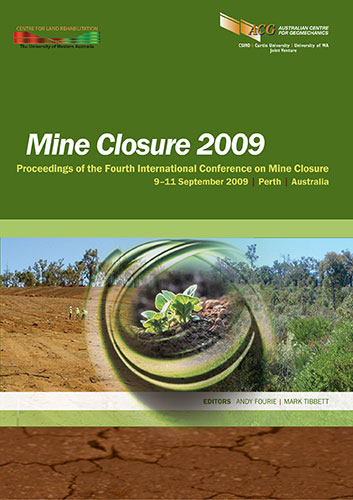Soil-vegetation feedbacks as a driver for early ecosystems development in the context of mine site rehabilitation

|
Authors: Hinz, C; Gwenzi, W; McGrath, G; Veneklaas, E; Scanlan, C Paper is not available for download Contact Us |
DOI https://doi.org/10.36487/ACG_repo/908_32
Cite As:
Hinz, C, Gwenzi, W, McGrath, G, Veneklaas, E & Scanlan, C 2009, 'Soil-vegetation feedbacks as a driver for early ecosystems development in the context of mine site rehabilitation', in AB Fourie & M Tibbett (eds), Mine Closure 2009: Proceedings of the Fourth International Conference on Mine Closure, Australian Centre for Geomechanics, Perth, pp. 431-438, https://doi.org/10.36487/ACG_repo/908_32
Abstract:
Highly disturbed ecosystems may undergo rapid changes due to the interaction between vegetation and soil that play a pivotal role for the water balance. This is particular true for water-limited ecosystems for which water availability determines biomass. Based on a review of how vegetation growth affects soil hydraulic properties, the authors propose a simple conceptual model that captures the feedbacks between soil water storage in soil and soil hydraulic behaviour and vegetation biomass. The feedbacks that were considered are (i) vegetation biomass and soil water storage, (ii) root growth and infiltration capacity, (iii) vegetation biomass and bare soil evaporation, and (iv) root growth and soil water drainage. In water-limited environments, these feedbacks are responsible for highly organised vegetation patterns in space and may also lead to oscillating behaviour of soil water storage and vegetation biomass in time. Biomass overshooting as a result of initially high soil water content is predicted, which is consistent with observations made in forested catchments after clearing or during revegetation of mine tailings. Implications of these feedbacks for predicting the early development of rehabilitated sites will be discussed.
References:
Baudena, M. and Provenzale, A. (2008) Rainfall intermittency and vegetation feedbacks in drylands, Hydrology and
Earth System Sciences, Vol. 12, pp. 679–689.
Breshears, D.D. (2005) The grassland–forest continuum: trends in ecosystem properties for woody plant mosaics?
Frontiers in Ecology, pp. 96–104.
Breshears, D.D., Cobb, N.S., Rich, P.M., Price, K.P., Allen, C.D., Balice, R.G., Romme, W.H., Kastens, J.H., Lisa
Floyd, M.L., Belnap, J., Anderson, J.J., Myers, O.B. and Meyer, C.W. (2005) Regional vegetation die-off in
response to global-change-type drought, Proceedings of the National Academy of Sciences, Vol. 102(41),
pp. 15144–15148.
D’Odorico, P., Laio, F. and Ridolfi, L. (2005) Noise-induced stability in dryland plant ecosystems. Proceedings of the
National Academy of Sciences, Vol. 102(31), pp. 10819–10822.
Donohue, R.J., Roderick, M.L. and McVicar, T.R. (2007) On the importance of including vegetation dynamics in
Budyko’s hydrological model, Hydrology and Earth System Sciences, Vol. 11, pp. 983–995.
Gilad, E., von Hardenberg, J., Provenzale, A., Shachake, M. and Meron, E. (2007) A mathematical model of plants as
ecosystem engineers, Journal of Theoretical Biology, Vol. 244, pp. 680–691.
Grant, C.D. (2005) State-and-transition successional model for bauxite mining rehabilitation in the jarrah forest of
Western Australia, Restoration Ecology, Vol. 14(1), pp. 28–37.
Harris, W.F., Santantonio, D. and McGinty, D. (1980) The dynamic belowground ecosystem, Forest: Fresh perspectives
from ecosystem analysis, In Proceedings of the 40th Annual Biology Colloquium, R.H. Waring (ed), Oregon
State University Press, Corvallis, Oregon, USA, pp. 119–129.
HilleRisLambers, R., Rietkerk, M., van den Bosch, F., Prins, H.H.T. and de Kroon, H. (2001) Vegetation pattern
formation in semi-arid grazing systems, Ecology, Vol. 82(1), pp. 50–61.
Modelica (2009) An open-source program capable of handling hybrid systems with discontinuities in state variables,
Rodriguez-Iturbe, I., D’Odorico, P., Porporato, A. and Ridolfi, L. (1999) On the spatial and temporal links between
vegetation, climate and soil moisture, Water Resource Research, Vol. 35, pp. 3709–3722.
Scheffer, M. and Carpenter, S.R. (2003) Catastrophic regime shifts in ecosystems: linking theory to observation, Trends
in Ecology and Evolution, Vol. 18(12), pp. 648–656.
Struthers, I., Hinz, C., Sivapalan, M., Deutschmann, G., Beese, F. and Meissner, R. (2003) Modelling the water balance
of a free-draining lysimeter using the downward approach, Hydrological Processes, Vol. 17, pp. 2151–2169.
Soil-vegetation feedbacks as a driver for early ecosystems development in the context C. Hinz et al.
of mine site rehabilitation
438 Mine Closure 2009, Perth, Australia
Ursino, N. (2007) Modeling banded vegetation patterns in semiarid regions: Interdependence between biomass growth
rate and relevant hydrological processes, Water Resource Research, Vol. 43, pp. 1–9.
© Copyright 2026, Australian Centre for Geomechanics (ACG), The University of Western Australia. All rights reserved.
View copyright/legal information
Please direct any queries or error reports to repository-acg@uwa.edu.au
View copyright/legal information
Please direct any queries or error reports to repository-acg@uwa.edu.au